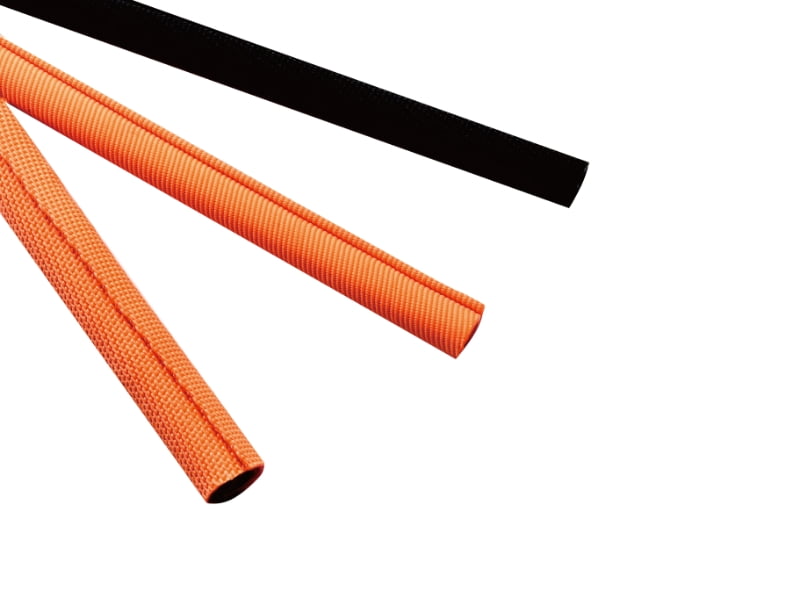Definition and Core Characteristics
Self-Closing Braided Sleeving is a specialized tubular mesh structure manufactured from interwoven synthetic filaments (typically polyester or nylon) that automatically contracts around cables or hoses without requiring additional closures. The unique 45° ±5° braid angle creates a memory effect that enables consistent self-closure while maintaining 15-30% axial stretch capability. This engineering textile exhibits exceptional dimensional stability with less than 2% shrinkage at 150°C and maintains flexibility down to -40°C.
Key technical specifications:
Temperature resistance: -40°C to +150°C continuous (short-term peaks to 180°C)
Flammability rating: UL VW-1 compliant with oxygen index >28%
Tensile strength: 50-120 N/mm² depending on material composition
Dielectric strength: >15 kV/mm for electrical insulation applications
Chemical resistance: Withstands IP67 immersion in oils, fuels, and weak acids

Engineering Advantages
The 3D diamond-braid architecture provides superior abrasion resistance, demonstrating >50,000 cycles in ASTM D4886 testing while maintaining structural integrity. The open-area ratio (typically 25-40%) facilitates exceptional heat dissipation, reducing cable bundle temperatures by 8-12°C compared to solid conduits. Electromagnetic compatibility is achieved through 85-95% coverage factor when using conductive variants with surface resistivities below 0.1 Ω/sq.
Application Scenarios
Industrial Automation
In robotic workcells, the sleeving withstands 10 million flex cycles at bending radii as tight as 4× cable diameter, protecting servo motor cables from particulate contamination and mechanical wear. The smooth inner surface (Ra <2.5 μm) prevents cable jacket abrasion during continuous motion.
Aerospace and Defense
Avionic harnesses utilize flame-retardant versions meeting FAR 25.853(a) vertical burn requirements, with weight savings of 40-60% compared to metal conduits. The material's -55°C to 200°C operational range ensures performance across extreme altitude conditions.
Renewable Energy
Solar tracking systems employ UV-stabilized (>2,000 hours Xenon arc resistance) sleeves that maintain 90% tensile strength after 10 years of outdoor exposure. The halogen-free composition prevents toxic fume generation during electrical faults.
Medical Equipment
Hospital devices use biocompatible (ISO 10993-5 compliant) sleeving that withstands >1,000 autoclave cycles at 134°C while providing 360° visibility for cable inspection.
Data Centers
High-density server racks implement EMI/RFI shielding versions achieving 60 dB attenuation from 10 MHz to 6 GHz, with airflow resistance 35% lower than solid cable trays.
Installation and Maintenance Protocols
Deployment Best Practices
For optimal performance, select sleeve diameter 1.3-1.5× the bundle diameter to ensure proper closure. Installation requires stretching the sleeve 15-20% beyond nominal length before cable insertion, allowing the braid to contract uniformly. Sharp edges should be protected with 3:1 bend ratio guides to prevent filament breakage.
Cleaning Procedures
For industrial environments:
Dry cleaning: Use compressed air (<7 bar pressure) at 30-45° angle to dislodge particulates
Wet cleaning: Immerse in pH-neutral detergent solutions (<5% concentration) at 40-60°C for 15-20 minutes
Ultrasonic cleaning: Effective for deep contamination using 40 kHz frequency for 3-5 minute cycles
Preventive Maintenance
Inspect sleeving every 6-12 months for:
Filament breakage (>5% damage per 100mm length indicates replacement)
Diameter expansion beyond 120% nominal size
Color fading exceeding ΔE>3 on CIELAB scale (UV degradation indicator)
Storage Conditions
Maintain optimal shelf life by storing in:
15-25°C temperature with 40-60% RH
Protected from direct sunlight (<50 klux exposure)
Coiled with >100mm bend radius to prevent permanent deformation
Material Selection Guide
| Material | Tensile Strength (N/mm²) | Max Temp (°C) | Chemical Resistance | Typical Applications |
|---|---|---|---|---|
| PET (Polyester) | 80-100 | 150 | Excellent | General industrial |
| PA66 (Nylon) | 90-120 | 125 | Good | Abrasion resistance |
| PTFE-coated | 60-80 | 260 | Exceptional | Chemical plants |
| Conductive PET | 70-90 | 150 | Excellent | EMI shielding |




 English
English

